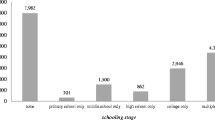Abstract
Purpose: In the context of a community development project related to adolescent sexual health, this study was carried out at Amherst Regional High School (ARHS) in Amherst, Nova Scotia, to assess students’ sexual health knowledge, gender differences in knowledge, and associations between knowledge and sexual behaviours.
Methods: A 29-item scale assessed knowledge in five areas of sexual health. Gender differences in correct responses to questions were compared. Overall knowledge scores were compared by gender, grade, and sexual activity, and tested for association with sexual behaviours.
Results: Of 796 students, 80% participated. Sexual health knowledge scores were highest for sexually active females. Higher score was associated with oral contraceptive use and later sexual debut. Knowledge was highest for HIV/AIDS. Students were insufficiently aware of their right to patient confidentiality.
Conclusions: ARHS students lack knowledge in some sexual health areas. School programs should consider these findings, and work to improve school-based sexual health education.
Résumé
Objectif: Cette étude a été réalisée à l’école se-condaire régionale d’Amherst, en Nouvelle-écosse, dans le cadre d’un projet de développement communautaire concernant la santé sexuelle des adolescents, afin d’évaluer les connaissances des étudiants en matière de santé sexuelle, les différences dans les connaissances entre les deux sexes, et les associations entre les connaissances et les comportements sexuels.
Méthodes: Une échelle comprennant 29 critères a permis d’évaluer les connaissances dans cinq domaines de la santé sexuelle. On a comparé les réponses correctes aux questions des garçons et des filles. Les résultats d’ensemble ont été comparés selon le sexe, l’année d’étude et l’activité sexuelle, en plus de les évaluer par rapport aux comportements sexuels.
Résultats: Sur 796 étudiants, le taux de participation a été de 80%. Pour ce qui est des connaissances de la sant’e sexuelle, les filles sexuellement actives ont eu les résultats les plus élevés. On a constaté une association entre les résultats élevés et l’utilisation d’un contraceptif oral ainsi qu’une initiation sexuelle plus tardive. Les résultats ont été les plus élevés s’agissant des connaissances relatives au VIH et au sida. Il est apparu que les étudiants n’étaient pas suffisamment au courant de leurs droits en matière de confidentialité du patient.
Conclusion: Les étudiants de l’école d’Amherst manquent de connaissances dans certains domaines de la santé sexuelle. Les programmes scolaires devraient prendre en compte ces résultats et s’efforcer d’améliorer l’éducation sexuelle faite dans les écoles.
Similar content being viewed by others
References
King AJC, Beazley RP, Warren WK, et al. The Canada Youth and AIDS Study. Kingston: Queen’s University, 1988.
King AJC, Beazley RP, Warren WK, et al. The Canada Youth and AIDS Study. Nova Scotia Report. Kingston: Queen’s University, 1988.
Langille DB, Beazley R, Shoveller J, Johnston G. Prevalence of high risk sexual behaviour in adolescents attending school in a county in Nova Scotia. Can J Public Health 1994;85:227–30.
Poulin C. Nova Scotia Student Drug Use 1996: Highlights Report. Nova Scotia Department of Health, 1997.
Gully PR, Rwetsiba DK. Chlamydial infection in Canada. CMAJ 1992;147:893–96.
Wadhera S, Strachan J. Teenage pregnancies in Canada, 1975–1989. Health Rep 1991;4:327–46.
Nova Scotia Department of Health. Fertility Report for Nova Scotia. Nova Scotia Department of Health: 1994.
Pope AJ, Westerfield C, Walker J. The effect of contraceptive knowledge source upon knowledge accuracy and contraceptive behavior. Health Educ Q 1985 (June-July):41–44.
Levinson RA. Reproductive and contraceptive knowledge, contraceptive self- efficacy, and contraceptive behavior among teenage women. Adolescence 1995;30:65–84.
Brooks-Gunn J, Furstenberg FF. Adolescent sexual behaviour. Am Psych 1989;2:249–57.
Marcy SA, Brown JS, Danielson R. Contraceptive use by adolescent females in relation to knowledge, and to time and method of contraceptive counseling. Res Nurs Health 1983;6:175–82.
Adler NE, Kegeles SM, Irwin CE, Wibblesman C. Adolescent contraceptive behaviour: An assessment of decision processes. J Pediatrics 1990;116:463–71.
Statistics Canada. Profile of Census Divisions and Sub-divisions in Nova Scotia. Catalogue No. 95-363. Canadian Census, 1991.
Beazley R, MacKinnon D, Langille D. A Sexuality Education Needs Assessment conducted With Students, Teachers and Guidance Counselors at E. B. Chandler Junior High School and Amherst Regional High School: A Report From the Amherst Initiative for Healthy Adolescent Sexuality. August, 1996.
Brown BB, Clasen DR, Eicher SA. Perceptions of peer pressure, peer conformity dispositions and self-reported behavior among adolescents. Dev Psychol 1986;22:521–30.
Santelli JS, Beilenson P. Risk factors for adolescent sexual behaviour, fertility, and sexually transmitted diseases. J Sch Health 1992;62:271–79.
Lewis CE, Lewis MA. Peer pressure and risk-taking behaviors in children. Am J Public Health 1984;74:580–84.
US Department of Health and Human Services. Chlamydia trachomatis infections. Policy Guidelines for Prevention and Control. 1985.
Cates W Jr. Sexually transmitted organisms and infertility: The proof of the pudding. Sex Transm Dis 1984;11:113–16.
Chow JM, Yonekura ML, Richwald GA, et al. The association between Chlamydia trachomatis and ectopic pregnancy. JAMA 1990;263:3164–67.
Wright SM, Gabb RG, Ryan MM. Reproductive health: Knowledge, attitudes and needs of adolescents. Med J Aust 1991;155:325–28.
Kraft P. Sexual knowledge among Norwegian adolescents. J Adolesc 1993;16:3–21.
Ringdahl EN. The role of the family physician in preventing teenage pregnancy. Am Fam Phys 1992;45:2215–20.
Fielding JE, Williams CA. Unintended pregnancy among teenagers: Important roles for primary care providers. Ann Intern Med 1991;114:599–601.
Alexander B, Cole-McGrew M, Shore W. Adolescent sexuality issues in office practice. Am Fam Phys 1991;44:1273–81.
Faulkenberry JR, Vincent M, James A, Johnson W. Coital behaviors, attitudes and knowledge of students who experience early coitus. Adolescence 1987;22:321–32.
Leland NL, Barth RP. Gender differences in knowledge, intentions, and behaviors concerning pregnancy and sexually transmitted disease prevention among adolescents. Adolesc Med 1992;13:589–99.
Kirby D. Sex and HIV/AIDS education in schools. BMJ 1995;311:403.
Author information
Authors and Affiliations
Corresponding author
Additional information
This research was supported by the National Health Research and Development Program of Health Canada, Project # 6603-1474-201
Rights and permissions
About this article
Cite this article
Langille, D.B., Andreou, P., Beazley, R.P. et al. Sexual Health Knowledge of Students at a High School in Nova Scotia. Can J Public Health 89, 85–89 (1998). https://doi.org/10.1007/BF03404394
Received:
Accepted:
Published:
Issue Date:
DOI: https://doi.org/10.1007/BF03404394



